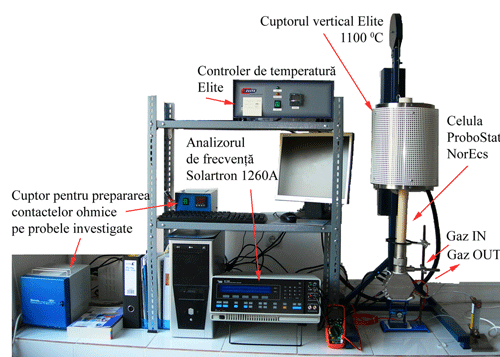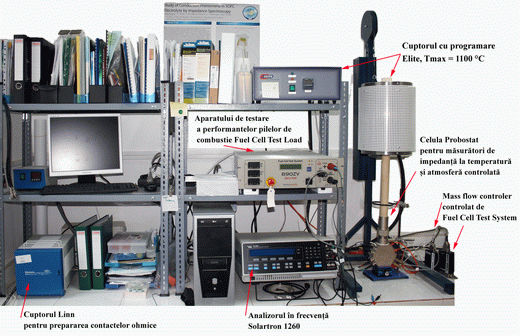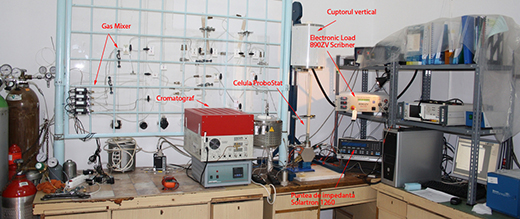The main goal
 The research project has the main goal the impedance spectroscopy (IS) implementation in the developing of a dedicated experimental stand for fully testing of conduction phenomena and electrical performances of intermediate temperature (~ 600 0C – 800 0C) solid oxide fuel cells (SOFC). The project is focusing in using impedance spectroscopy for studying the electric proprieties of each oxide materials structure which will be SOFCs component: the anode, the cathode and the electrolyte and partial assembled structures as anode – electrolyte and cathode - electrolyte.
The research project has the main goal the impedance spectroscopy (IS) implementation in the developing of a dedicated experimental stand for fully testing of conduction phenomena and electrical performances of intermediate temperature (~ 600 0C – 800 0C) solid oxide fuel cells (SOFC). The project is focusing in using impedance spectroscopy for studying the electric proprieties of each oxide materials structure which will be SOFCs component: the anode, the cathode and the electrolyte and partial assembled structures as anode – electrolyte and cathode - electrolyte.
Objectives, methodology and expected results of the project
top
The general objective of the project is the implementation of impedance spectroscopy in developing of a complex experimental stand for characterization of the intermediate temperature fuel cell in real work conditions.
The specific objectives of the project are the following:
Firs year of the project:
1) Tune up the experimental setup for materials characterization using impedance spectroscopy (IS) at various temperatures.Methodology. The group which is development of oxide materials has acquired recently an high end frequencies analyzer, first in Romania, SOLARTRON 1260A, range of frequency 10 µHz – 32 MHz range frequency, a dedicated measurement cell for IS measurements in controlled atmosphere and temperature – tip ProboStat made by NorEcs. The cell temperature is controlled using a vertical furnace system 12000 C – Elite Thermal System and the Eurotherm 2216e temperature controller. This objective will be achieved by interconnection of all instruments using a computer and National Instruments GPIB interface. In this way we will get capability to measure IS versus temperature in automat mode. In this step we will connect the cell to gases bottles and we will mount gases sensors. I will develop software for processes measurements data files.
2) Structural characterization (morphology, defects) using SEM and chemical composition characterization with XPS for each oxide structure which will use as anode, electrolyte and cathode for building intermediate temperature SOFC.
Methodology. SEM and XPS measurements will be made in our institute. These investigations will help us to find the most suitable composition for the oxide structures.
3) Investigations on electrical proprieties versus temperature using IS for each oxide structure which will use as anode, electrolyte and cathode for building intermediate temperature SOFC.
Methodology. We will identify the components of equivalent electrical circuit which describe the electrical behavior of investigated materials and the transport charge mechanisms from them.
The second year of the project:
4) Characterization of electrical proprieties versus temperature using impedance spectroscopy for partial ensembles structures as anode – electrolyte and cathode – electrolyte.
Methodology. The selected oxide materials structures after the characterizations from the second objective will be tested using impedance spectroscopy. These tests will be done on pears of anode-electrolyte and cathode-electrolyte for extract more information before the fuel cell assembling.
5) The developing of an experimental stand dedicated to fuel cell assembling and testing of their performances in real work conditions.
Methodology. The group who is researching the oxide materials has developed a new method to build fuel cells using spin coating and screen printing. Following the above objective we are going to improve this building method. The special design of ProbaStat measurement cell combined with the state of art frequency analyzer Solartron 1260 A allow as to test using impedance spectroscopy the electrical performances of the fuel cells in real work conditions – the anode in hydrogen atmosphere, cathode in the air and the whole assembly in controlled temperature.
Results
top
The experimantal stand for for studying the electric proprieties by impedance spectroscopy, 2011

The final experimental stand for testing electrical performance of SOFC in real work conditions, 2012
Conferences
- The Third Regional Symposium on Electrochemisty South East Europe, Bucharest, Romania, 2012, ”AC Impedance Spectroscopy and X-ray Photoelectron Spectroscopy on (La,Sr)(Ga,Mg)O3-δ electrolyte”, Rareş Scurtu, Cristian Antonescu, Victor Fruth.
- The Third Regional Symposium on Electrochemisty South East Europe, Bucharest, Romania, 2012, ”Properties of La0.6Sr0.4Fe0.8Co0.2O3-δ Ceramics as Cathode Material for Solid Oxide Fuel Cells”, Daniela Berger, Andrei G. Tomulescu, Rares Scurtu, Cristian Matei
- 12th Conference of the European Ceramic Society, ECerS XII, Stockholm, Sweden, 2011, "Solid electrolytes for SOFC cells based on CeO2", Maria Preda, Alina Melinescu, Victor Fruth, Rares Scurtu, Georgeta Velciu, Virgil Marinescu, Maria Zaharescu.
- 12th Conference of the European Ceramic Society, ECerS XII, Stockholm, Sweden, 2011, "Sintered LaCoO3 ceramics obtained from aqueous sol-gel reactive powders", Maria Zaharescu, Luminita Predoana, Barbara Malic, Dorel Crisan, Nicolae Dragan, Jose Calderon-Moreno, Rares Scurtu.
- 12th Conference of the European Ceramic Society, ECerS XII, Stockholm, Sweden, 2011, "A comparative study on nanostructured zirconia ceramics and nanocomposites sintered by different methods", Bogdan Stefan Vasile, Ecaterina Andronescu, Cristina Ghitulica, Lavinia Curechiu, Rares Scurtu, Georgeta Pall.
- Al X-lea Simpozion naţional de pulberi ceramice, Bucureşti 17.11.2011 organizat de Societatea Română de Ceramică, "Testarea pilelor de combustie de tip SOFC prin spectrocopie de impedanţă", R. Scurtu, A. Melinescu, V. Fruth, G. Velciu, V. Marinescu, M. Preda – prezentare orală.
- Second Workshop on Size-Dependent Effects in Materials for Enviromental Protection and Energy Application (SIZEMAT 2), September 2010, Nessebar, Bulgaria, "IT-SOFC Electrolytes Investigated by Impedance Spectroscopy", Rares Scurtu, Cristian Antonescu, Victor Fruth.
- The 7th International Conference of the Chemical Societies of the South-East European Countries on "Chemistry - Beauty and Application" (ICOSECS), September 2010, Bucharest, Romania, "Impedance Spectroscopy Characterization of La0.8Sr0.2Ga0.83Mg0.17O3-δ as Electrolyte for IT-SOFC", Rares Scurtu, Cristian Antonescu, Victor Fruth.
Publication
- "LaCoO3 ceramics obtained from reactive powders", Predoana Luminita, Malic Barbara, Crisan Dorel, Dragan Nicolae, Anastasescu Mihai, Calderon Moreno Jose, Scurtu Rares, Zaharescu Maria, Ceramics International, 2012. 38(7): p. 5433-5443
- . "Densification of doped lanthanum gallate (LSGM) electrolytes using activated microwave field", C. Andronescu,V. Fruth, E. Volceanov, R. Scurtu, C. Munteanu, M. Zaharescu, – trimis spre publicare la Ceramics International
- "Processing of (La,Sr) (Ga,Mg)O3 solid electrolyte using an enhanced mixed oxide route", Victor Fruth, Cristian Andronescu, Cristian Hornoiu, Ecaterina Ţenea, Adriana Rusu, Rareş Scurtu, în curs de publicare în nr. 1/2011 al Revistei Române de Materiale.
